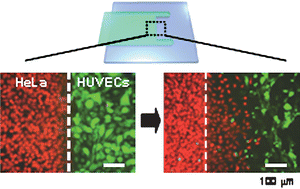We investigated the interactions between HeLa cells and human umbilical vein endothelial cells (HUVECs) by monitoring their movements in a controllable coculture system. Two complementary, detachable, cell-substrates, one of polystyrene (PS) and the other of poly(dimethylsiloxane) (PDMS), were fabricated by replica molding. Coculturing was started by mechanically assembling two complementary substrates. One substrate was covered with a confluent layer of HeLa cells and its complement covered with confluent HUVECs. Using this coculture system as a tumor/endothelium model, we found that the HeLa cells migrated towards the HUVECs, while, simultaneously, the HUVECs retreated and that both types of cells migrated approximately twice as rapidly (two hundred microns per twenty-four hours) as they did alone. Additionally, when direct contact between the two cell types was prevented, the HUVECs initially migrated towards the HeLa cells and then retreated. The characteristics of the cell movements, i.e. direction and speed, probably are consequences of cell–cell signaling, with such signals possibly important during tumor cell intra- and extravasation.

You have access to this article
 Please wait while we load your content...
Something went wrong. Try again?
Please wait while we load your content...
Something went wrong. Try again?


 Please wait while we load your content...
Please wait while we load your content...